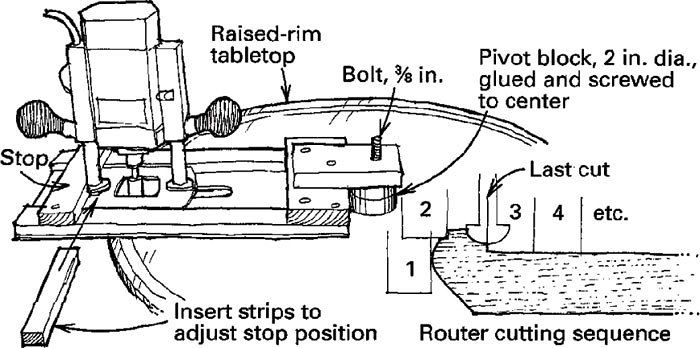Routing a Raised-Rim Tabletop

In reproducing an 18th-century pedestal table, I was faced with the problem of forming a raised-rim top. The traditional method was to use a lathe for this process. But even my small 25-in. top was far beyond the capacity of my lathe. So I devised this router jig to shape the table’s top.
First, I cut the top to the required diameter on a bandsaw and then screwed a pivot block holding a countersunk 3/8-in. bolt to the center of the top. The sinking was to be 5/16 in. deep, so I made sure the pivot block’s screws only penetrated 1/4 in. Then I made the fixture to pivot on the bolt. With a two-flute straight bit in the router, I initially used the setup to true the edge of the top to a perfect circle; I made subsequent cuts from the outside in. To avoid having to move the stop for each cut, I inserted spacing strips to position the router for up to four sweeps of the jig before I had to reposition the stop. When as much as possible of the sinking had been done in this way, I used a core-box bit to form the cove on the rim. To sink the central part of the table, I removed the pivot block and lengthened the base of the jig to span the width of the top. Finally, I smoothed the entire recessed top with a plane and a scraper.
Dr. Ralph Sinnott, Wolverhampton, England
Fine Woodworking Magazine, February 1993 No. 98

Fine Woodworking Recommended Products

Jorgensen 6 inch Bar Clamp Set, 4 Pack

Stanley Powerlock 16-ft. tape measure

Estwing Dead-Blow Mallet




















Log in or create an account to post a comment.
Sign up Log in